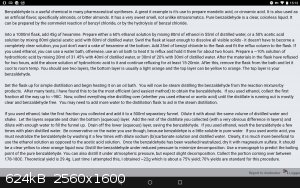Murexide
Hazard to Self
 
Posts: 51
Registered: 1-12-2018
Member Is Offline
|
|
Obtaining Benzaldehyde
Benzaldehyde is used for many applications in organic syntheses (Cannizzaro reaction, condensation with acetone, making anti-seizure medications etc.)
that seem amateur friendly. Obtaining benzaldehyde is however a concern.
Benzaldehyde is available as bitter almond oil (approx. $30 for 100mL online - Australia), and not available OTC. The main concern is the cyanide
present in the sample (it is even advertised to contain cyanide as a toxin). Certainly, performing organic reactions with cyanide is unacceptable due
to the risk of HCN leakage.
Benzaldehyde can also be obtained from retro-aldol reaction (of cinnamaldehyde) or from partial oxidation of benzyl alcohol, both of which are
available at around the same price as benzaldehyde in pure form and without issue. These procedures are however very cumbersome from what I have read
on SM and involve steam distillation procedures (requiring glassware which I do not have).
How significant is this cyanide contamination, and otherwise what routes are viable to benzaldehyde?
|
|
|
j_sum1
Administrator
       
Posts: 6320
Registered: 4-10-2014
Location: At home
Member Is Offline
Mood: Most of the ducks are in a row
|
|
There is a thread here on toluene to benzaldehyde. Good luck. I thhink it is possible using KMnO4 and a catalyst. But tricky. I have had a go and
obtained an odour but nothing more.
Oxidation of benzyl alcohol using chromyl chloride seems to be reliable. Coincidentally I was watching NileRed on this today. Chromal chloride is not
without its own issues though.
There are probably other routes.
|
|
|
j_sum1
|
Thread Pruned
21-12-2018 at 21:02 |
Tellurium
Hazard to Self
 
Posts: 84
Registered: 12-7-2017
Location: Group 16, Chalcogen City
Member Is Offline
Mood: smelly
|
|
I don't think, that there is HCN present, I think it would react with the benzaldehyde to form the corresponding cyanohydrin. Even if it's present
there should just be trace amounts in it, for some applications the benzoic acid, that's formed from the Benzaldehyde due to oxidation would be more
of a concern, especially if the stuff is a bit older it can be quite a lot. So I would advise you to distill the Bitter Almond oil before using.
In terms of the HCN: Bitter almonds don't contain the HCN directly, but around 5% amygdaline, which only contains around 0,3% HCN, also it normal is
just slowly released enzymatic, so that shouldn't be that dangerous. Do the destillation outside or in a well ventilated area and you should be safe.
If you want to be sure maybe test for cyanides using a mix of Fe²⁺ and Fe³⁺ Ions.
|
|
|
Justin Blaise
Hazard to Self
 
Posts: 82
Registered: 5-10-2011
Location: Parts Unknown
Member Is Offline
Mood: No Mood
|
|
If you can get a hold of benzyl alcohol, then the Anelli oxidation would give you benzaldehyde. You need TEMPO as a catalyst and bleach as the
oxidant. TEMPO can be hard to get a hold of, but Melgar is currently offering it in the Reagents and Apparatus Acquisition forum.
Once, out of curiosity, I ran GCMS on an almond fragrance for making candles and it turned out that it was something like 70% benzaldehyde and 30%
benzyl benzoate. If I can find the brand I'll let you know. But that seems like an easy distillation and that product definitely doesn't contain HCN
(not that I think your product does either. If it's for general consumers I can't imagine HCN being present).
Edit: this is the product that I can confirm the composition of https://keystonecandlesupplies.com/products/almond-pastries?...
[Edited on 23-12-2018 by Justin Blaise]
|
|
|
deadrush
Harmless

Posts: 21
Registered: 3-3-2014
Location: Worcester MA
Member Is Offline
Mood: Fungible
|
|
Just wondering but could one freeze off the benzyl benzoate from the benzaldehyde? Its melting point is 18C.
|
|
|
Texium
Administrator
       
Posts: 4579
Registered: 11-1-2014
Location: Salt Lake City
Member Is Offline
Mood: PhD candidate!
|
|
Maybe to an extent, but much of it would probably stay dissolved in the benzaldehyde. Vacuum distillation would be much more effective.
|
|
|
Texium
|
Thread Moved
25-3-2024 at 12:47 |
SplendidAcylation
Hazard to Others
  
Posts: 203
Registered: 28-10-2018
Location: Starving in some deep mystery
Member Is Offline
Mood: No one I think is in my tree.
|
|
Two possible methods
Hi,
The oxidation of benzyl alcohol using nitric acid is very effective, there is a photo essay on here somewhere which I have followed successfully.
Also, probably one of the most "OTC" routes is the Sommelet reaction, starting with benzyl chloride and hexamine.
Attached is a nice write-up, a screenshot from the Vespiary, illustrating the procedure.
I have followed this procedure with good results and comparable yields to the ones mentioned.
If you don't have benzyl chloride you can make it from benzyl alcohol and hydrochloric acid.

|
|
|
Mateo_swe
National Hazard
   
Posts: 541
Registered: 24-8-2019
Location: Within EU
Member Is Offline
|
|
Benzaldehyde is avaliable on ebay if you are in Europe or UK.
Just search for benzaldehyde or Bitter Almond.
|
|
|
thermochromic
Harmless

Posts: 17
Registered: 17-1-2018
Member Is Offline
Mood: No Mood
|
|
Y'all are over complicating it
it is much easier than the toluene synth. Oxidize benzyl alcohol with KMnO4. Just throw the two together (with care of course). It resists further
oxidation. There is a research paper in Nature that explains why it does but trust me. It works.
Here is paper:
https://www.nature.com/articles/ncomms4332.pdf
|
|
|